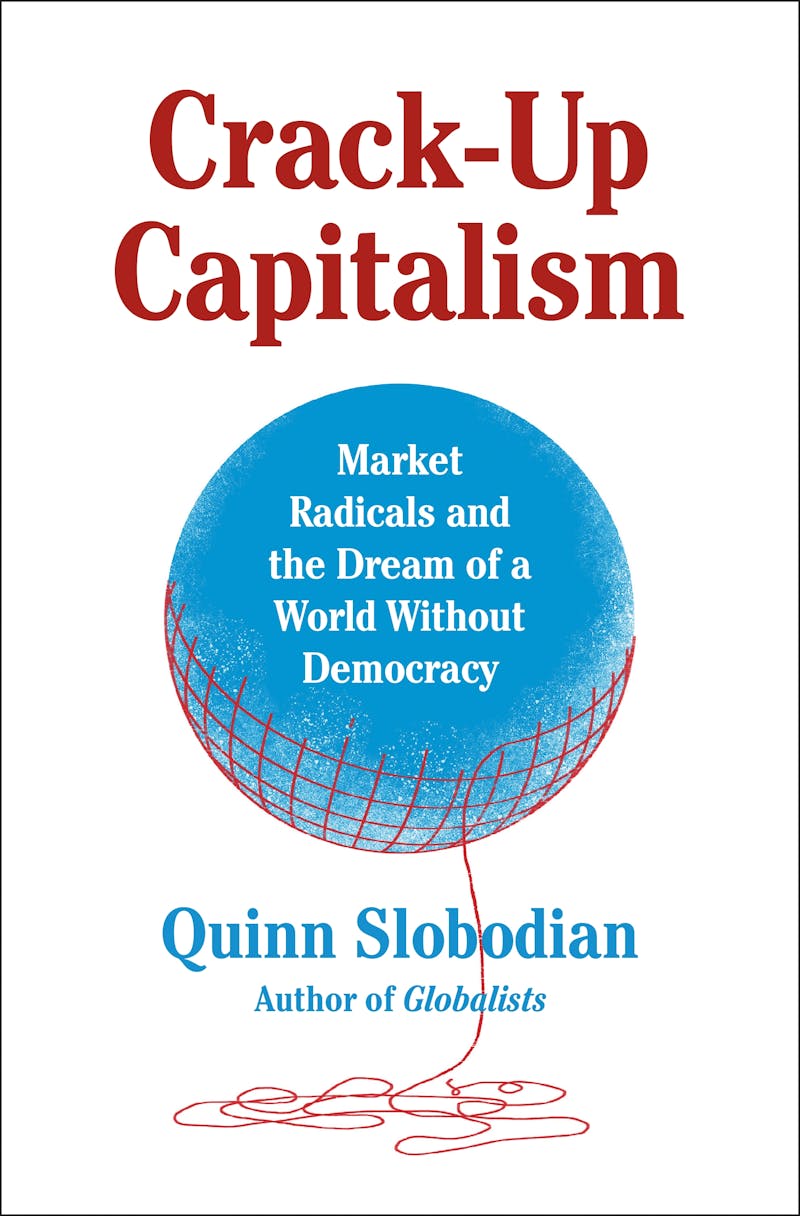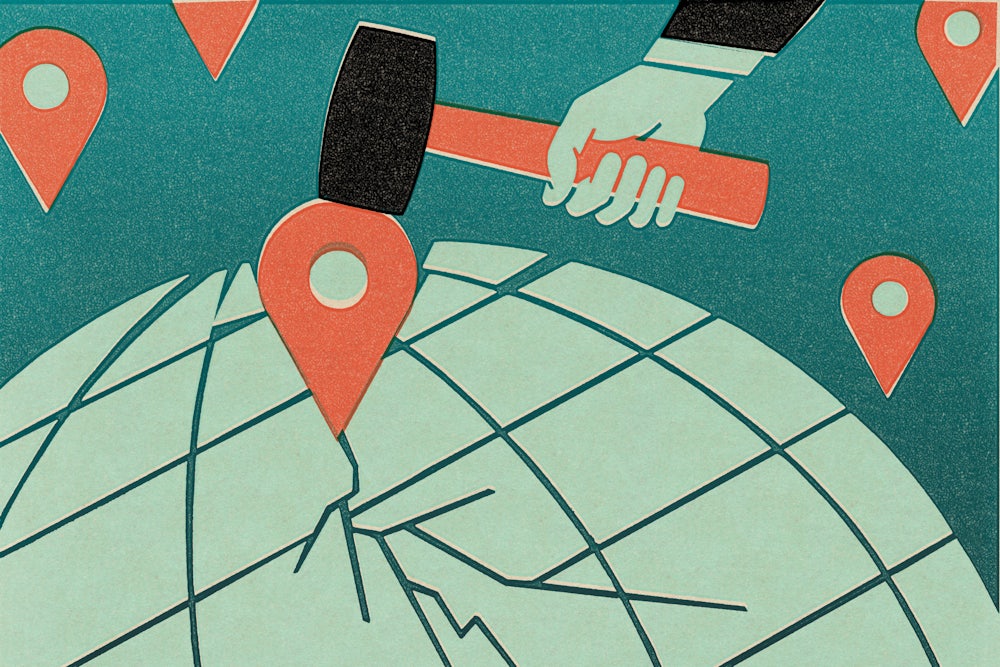In 1978, from a shiny metropolis off China’s southern coast, a giddy Milton Friedman glimpsed the world as he thought it should be. “If you want to see how the free market really works,” he told viewers of his PBS series, Free to Choose, “this is the place to come.” He was speaking of Hong Kong, a place that had miraculously mined freedom and prosperity from “barren rock” through hard work, risk-taking, and a state “limited to its proper function”—a grim euphemism that Friedman meant as high praise.
At that time, Hong Kong was a British colony where residents had little say over their own affairs. Its powerful colonial governor was named almost 6,000 miles away by Queen Elizabeth, and only a portion of seats in the legislature were elected. In 1997, Hong Kong was returned to Chinese rule under a “one country, two systems” framework that was intended to preserve its economic advantages, but that did not bring democracy. This did not trouble free marketeers, who saw a high-tech industrial powerhouse, supposedly stripped of the irrational passions of mass politics and the nettlesome strictures of formal democratic procedure. As historian Quinn Slobodian puts it, it made an “impeccable vessel for commerce and finance—armored against the demands of the population but nimbly responsive to the demands of the market.” Why couldn’t everywhere be more like this?

Hong Kong today is among the most unequal places on Earth, but the Hong Kong model is thriving. As Slobodian traces in his incisive new book, Crack-Up Capitalism: Market Radicals and the Dream of a World Without Democracy, the world today is riddled with economic zones: places within countries that in one way or another have come to be roped off from the regulatory reach of national governments. In 1986, there were 176 such zones; by 2018, there were 5,400. Some are city-states or duty-free districts. A few “are no bigger than a factory or a warehouse,” while “others are urban megaprojects.” Zones don’t formally break off from the state, but they sidestep it. Each corporation that stashes its profits “in Switzerland or the Caribbean; each standoff over grazing rights with federal agents; each rent-a-cop, contractor, or mercenary hired to patrol, jail, or raid,” Slobodian writes, is “another small victory for the zone.”
The proliferation of zones is not just about economic growth. It’s part of a larger antisocial project deeply hostile to democracy. Market radicals have long seen liberal democracies as petty tyrannies whose taxes and regulations constrain the free flow of capital. Slobodian’s previous book, Globalists: The End of Empire and the Birth of Neoliberalism, examined the creation of a global system designed to circumvent those constraints. But, as Crack-Up Capitalism traces, the ultimate goal was to chip away through elaborate means at the states themselves. Zones were the tool of choice. As Heritage Foundation analyst Stuart Butler wrote in 1982, “Localized freedom can rot the foundations of the unfree state around it.” The point of the zone, Slobodian explains, is “to pierce holes in the social fabric,” breaking up the bonds of solidarity within communities—as the wealthy hole up in gated communities, and workers come and go with no social safety net—and leaving the map in fragments.
Zones are not an entirely novel form. As Slobodian points out, the city-state flourished in the Middle Ages; Genoa, Venice, and the City of London had their own governments, and, as in Hong Kong today, businesses could vote. But, in his account, the rise of the zone as we know it can be traced to the 1970s, when it appeared to offer “a sleek alternative to the messiness of mass democracy and the sprawl and bloat of unwieldy nation-states.” In an era of economic stagnation, when unemployment and inflation surged, zones appeared to have cracked the code to prosperity.
China began to replicate the Hong Kong model within its own borders in 1979, when Deng Xiaoping established four experimental Special Economic Zones to the north of Hong Kong in the Pearl River Delta, leading to the growth of the industrial powerhouse of Shenzhen. In the United States, Steve Savas, an official in the Department of Housing and Urban Development, proposed transforming New York City into a “Hong Kong on the Hudson.” And in the United Kingdom, Margaret Thatcher’s adviser Keith Joseph contemplated creating zones without taxation, labor laws, or health and safety regulations, but doing so in pockets of “inner city decay” instead of on literal islands. In her first year in office, Thatcher created the first of 11 enterprise zones.
Her most ambitious experiment with zones, however, was in London. Plans for the sleek glass complex known as Canary Wharf—and nicknamed “Hong-Kong-on-Thames”—were unveiled in 1985. The site for the new construction was London’s West India Docks, which was once the largest port in the world but had been hollowed out by containerization. After the docks finally closed in the 1980s, the area was earmarked for regeneration. But instead of a revitalized neighborhood for working people, there would rise a supercharged new financial district. The original plan included three of the tallest buildings in Europe and 10 million square feet of office space to accommodate the “vast floors of monitors and cooling systems” required in “the new age of ‘electronic banking.’”
The developers set their own rules: The London Docklands Development Corporation was empowered to “bypass local government, forgo the usual planning permission, and ignore the housing needs of residents.” When locals voiced their opposition—the Greater London Council warned of a future in which locals would be “porters and lavatory attendants for passing businessmen” and put forward an alternative plan—their concerns were waved aside. The LDDC’s first director in fact openly bemoaned what he called the “surplus population” of existing residents. (And in 1986, Thatcher’s government dissolved the troublemaking GLC.) Canary Wharf today is a private oasis for bankers, where low-paid cleaning staff have been banned from protesting.
New York City’s Hudson Yards, referred to as “Manhattan’s Biggest, Newest, Slickest Gated Community” by the New York Times architecture critic, is a more recent manifestation of the zone model, one that lavishes tax incentives and other privileges on wealthy investors willing to relocate to purportedly distressed areas. At least $1.2 billion of the financing to build Hudson Yards was obtained through the EB-5 visa program, a federal initiative that provides foreigners who invest heavily in U.S.-based projects a path to permanent residency in return. This program was supposed to direct resources to remote or economically distressed regions—though Manhattan’s West Side is neither remote nor distressed. Empire State Development, a New York state agency, got around this problem by cobbling together an enterprise zone out of “a serpentine line of census tracts from genuinely economically depressed areas,” thus opening the floodgates of EB-5 money. As Bloomberg’s Kriston Capps reported in 2019, “the mega-luxury of this mini-Dubai was financed in part through a program that was supposed to help alleviate urban poverty.” This kind of transactionalism is what Slobodian has in mind when he writes that enterprise zones function largely to “make what had been formerly called corruption into the law of the land.”
Hong Kong was far from the only model for new zones. In the late 1980s, Friedman and the Hoover Institution fellow Alvin Rabushka put together an index of the most “economically free” countries in the world. High on the list was Singapore. By the 1990s, Singapore had been undergoing steady economic growth at a rate unseen anywhere else, achieved through a combination of state-led internal development and a zealous drive to insert itself into high-end global supply chains. Unlike Hong Kong, Singapore is an independent nation with multiparty elections, though it is hardly a robust democracy: The watchdog Freedom House gives it a score of 19 out of 40 on political rights. A defining feature of its economy is the divide between citizens and the foreign workers who sustain the city-state’s economy. “Being a Singaporean citizen means access to a range of services including a compulsory savings account that one could draw on for pension, health care, and to buy a home,” Slobodian notes. “Being a foreign worker means you are not just hire-and-fire but fire-and-deport.”
Despite its democratic deficit—or more probably because of it—Margaret Thatcher once suggested that Britain look not to Europe but to the East to reinvent itself as “a kind of free-trade and non-interventionist ‘Singapore.’” More recently, Brexiteers fawned over Singapore as well. “If we are to thrive,” Conservative MP Owen Paterson asserted in 2017, “our post-Brexit model should exactly be Singapore, a tiny country devoid of natural resources but with a booming economy and an average life expectancy of 85.” The Economist gushed at the thought of London as “a sort of Singapore on steroids”—a vision of prosperity that has yet to materialize in the U.K., where the government warned of power outages last winter and supermarkets began to ration fresh fruit and vegetables earlier this year.
The creation of zones has not always meant gleaming towers and crowded ports. In South Africa, market radicals seized on apartheid policies to put the zone offense into action. Ciskei was one of several territories that the apartheid government designated a “homeland” for the Black population. Under this policy, Black South Africans were stripped of their citizenship and told they were citizens of these new pseudo-states instead; over 3.5 million people were forcibly relocated as a result. Seeing these developments, libertarians “hoped that the homeland could work as a kind of zone,” Slobodian explains; with the help of “economists who believe in the power of markets, prices and incentives,” it could become, depending which paper you consulted, the “African Hong Kong” or “Africa’s Switzerland.”
They got their chance to weigh in directly in 1984 when Ciskei’s leader, Chief Lennox Sebe, put together a commission on economic policy. The head of the commission was Leon Louw, a South African inspired by Hong Kong, Friedman, and Friedrich Hayek. The model he proposed was the Export Processing Zone, which essentially created an internal offshore space with few regulations or rules to turn off investors. The strategy was to undercut countries like Taiwan by paying even lower wages. “This is like Taiwan 30 or 40 years ago: no competition, cheap labor,” one investor enthused. Rapid industrialization followed, as did violent state coercion: “the would-be libertarian utopia operated hand in glove with the South African security forces,” cracking down on dissent and any attempt at labor organizing.
In a similar instance of opportunism, market radicals also took an interest in war-torn Somalia in the 1990s. In that story, Michael van Notten, a prominent Dutch libertarian thinker and attorney whose claim to fame was the idea of the tax-free T-zone, would take the lead. Van Notten’s signature scheme called for ending taxes in certain strategic locales to arouse what one economist called a “stimulating jealousy” in the surrounding area. In this way, lower taxation might spread by osmosis as communities raced to the bottom in order to remain competitive. In the Horn of Africa, he called for the creation of a society with no central government, ruled instead by judges rooted in the legitimacy of traditional Somali law. Individual Somali clans, as van Notten’s Somali wife explained, would be able to profit from their “statelessness by opening areas within their tribal lands for development, inviting businessmen and professionals the world over to come to take advantage of the absence of a central government or other coercive authority.”
Van Notten’s misadventures would eventually lead to him being deported for taking part in a land transfer scheme gone awry. Africa would also provide the backdrop for yet another market radical proposal. Pitching the idea of charter cities, Stanford economist Paul Romer pointed to a map of the continent at night. Noting how little of it was illuminated, he lamented the “enormous amount of land on earth that’s very underutilized.” His plan called for rich countries to effectively take over unused swaths of poorer nations and create ideal conditions for capital to flourish. “This would be colonialism by consent,” Slobodian observes, “occupation by invitation.”
In the United States, recent decades have seen the momentum of market radicalism moving west. Far from the ossified Eastern establishment, libertarians could work toward a stateless future in their own enclaves. A major part of this wide-ranging yet surreptitious effort lies in the construction of gated communities meant to facilitate retreat from the obligations of democratic society. Libertarians embraced such developments as showcases for polycentric law, a system of competing and overlapping legal institutions in which individuals and organizations can choose which they want to subscribe to. Different laws would apply to different people under different conditions. “This was what Hans-Hermann Hoppe called the ‘hierarchic-anarchic’ order of the medieval era,” Slobodian explains. For example, Sea Ranch, a gated planned community that sprung up in the 1960s along California’s northern coast, has long been ordered by a binding 56-page document called The Sea Ranch Restrictions. To violate its strictures on the height of trees or the colors of drapes was to risk fines or even the termination of member privileges.
It is easy to laugh off those who would want to live in such places. Their most fervent advocates often embrace frankly goofy ideas about the past, attempting to govern these private fiefdoms under a discrete set of paternalistic norms. But by the turn of the century, roughly half of new developments in the Western and Southern United States were carefully planned and walled off, many with their own private security forces. Over a similar period, many households also retreated from public education, turning to homeschooling: Roughly 20,000 children were being taught at home in the 1970s, compared with 1.7 million by 2016. Such living arrangements represent a hermetic ideal, escapist redoubts for those who reject rules and norms decided by a democratic collective.
Fantasies of opting out go beyond terra firma. Some libertarians look to settlements on the high seas to evade the reach of government. Others have looked to the internet: Balaji Srinivasan’s pitch for a “cloud country” presents a kind of micronation to be founded online and eventually manifested in the real world by individual users through discrete economic incentives. This novel state would emerge as an open-source project, its Founding Fathers hashing out the details on the web. “We cultivate in-person levels of civility,” Srinivasan mused, “we simulate architecture in VR, and we create art and literature that reflects our values.” A public dashboard would tally the number of members (citizens?)—“and perhaps their investments or fees,” Slobodian notes. At some later date, the purchase of physical territory could be crowdsourced. If citizenship as profile status does not arouse your civic passion, Srinivasan’s vision may not be for you.
Efforts like the sprawling myriad of gated communities, attempts to will new polities into being at sea and in the cloud, or Starbase—“a patch of land in Texas bought by Elon Musk to launch SpaceX rockets, which Musk also pictured as a community that would sustain future shuttles commuting to off-world settlements”—are only today’s most conspicuous efforts to undermine a shared civic space, materially and metaphorically. “We are being encouraged,” Slobodian argues, “to live in zones by those who profit most by our abdication from the shared set of responsibilities. A hundred years ago, the robber barons built libraries. Today, they build spaceships.”
The rhetoric that so often drives the creation of economic zones holds that individuals know best how to attain personal prosperity, and that they should be free of the meddlesome prerogatives of the state in pursuit of their own interests, for better or for worse. Even if it were true that most working people in Hong Kong, Somalia, Singapore, London, or Shenzhen were materially better off than their counterparts elsewhere—and it’s not clear that they are—there would still be the question of how to contend with the unequal distribution of power. Milton Friedman argued decades ago that the beauty of the Hong Kong model lay in its voluntary nature. Workers were supposedly free to enter and exit employment agreements based on their own calculations of what their labor was worth. Freer workers were happier workers.
The reality is much less romantic, as demonstrated 10 years ago in Singapore. The traffic death of an Indian construction worker in 2013 led to rioting that drew international attention to the abysmal living conditions of the South Asian, Chinese, Thai, and Burmese workers so crucial to Singapore’s narrative of economic success. And in Hong Kong, the Chinese government’s suppression of democracy activists has led to the most sustained protests in the city’s history.
There are glimmers of successful resistance. Zones for Employment and Economic Development (ZEDEs) were foisted upon Honduras as a constitutional amendment after a coup in 2009. In 2021, a venture capitalist named Erick Brimen established a ZEDE on the Honduran island of Roatán and began work there on a charter city modeled after Hong Kong, Singapore, and Dubai. The city, which he called Próspera, would have a police force and its own legal system, which would treat crimes as mere “breaches of contract.” Government would be left to a set of corporate structures—a technical secretary, a limited liability company based in Delaware, and a group of trustees—rather than elected officials. The plans quickly drew opposition; Honduras has a long history of exploitation by foreign corporations, from U.S. banana companies to foreign-owned sweatshops, and the zones appeared to be yet another incursion. A National Movement Against ZEDEs and for National Sovereignty channeled the anger of ordinary people, and last year, after sustained protests, Honduras’s Congress unanimously revoked the status of ZEDEs altogether.
The case of Próspera is a reminder that zones are everywhere, but they are not inviolable. Those of us who don’t live in zones might think they don’t affect us, but the same ideas Slobodian outlines here have imbricated themselves into the very workings of globalized capitalism. A growing number of immiserated workers finding themselves with fewer and fewer ways to push back against exploitation are just one symptom. What is the Uberfication of the economy but an extension of the worker “freedom” Friedman celebrated in Hong Kong? The spirit of the zone is not contained within its deliberately narrow confines. The market radicals have designs upon us all.






